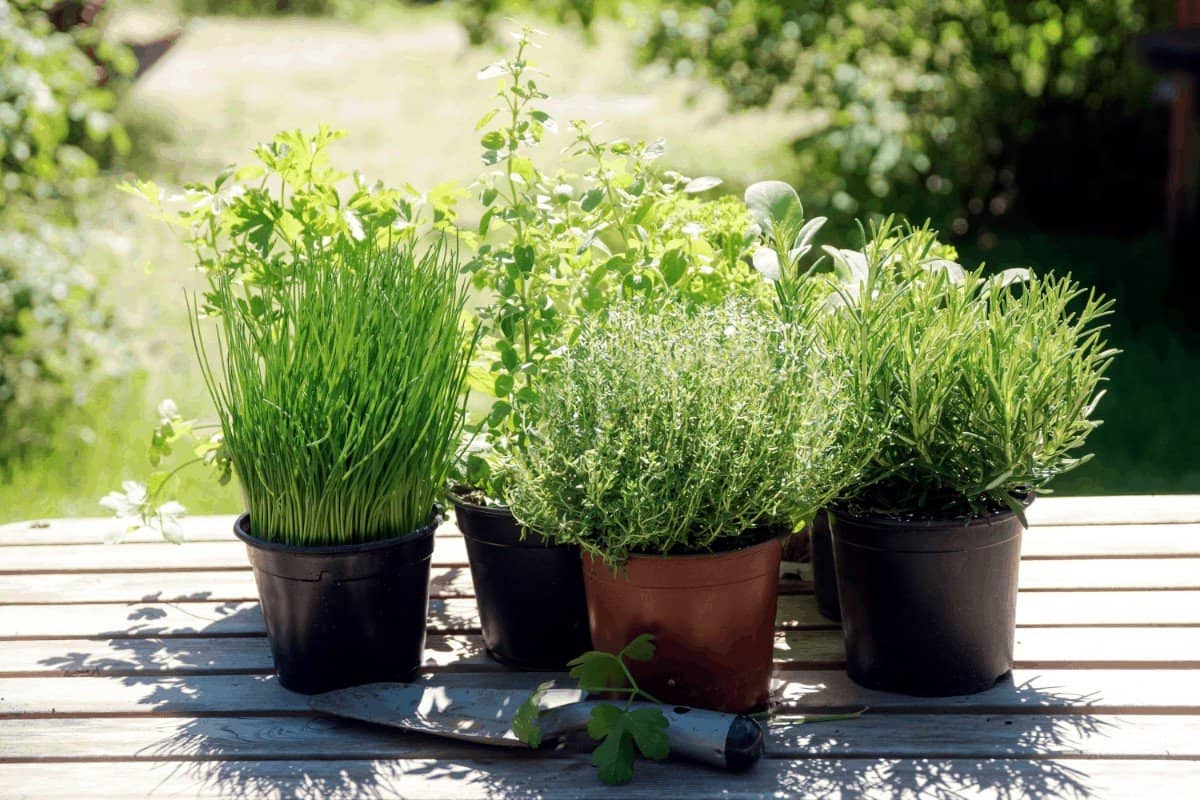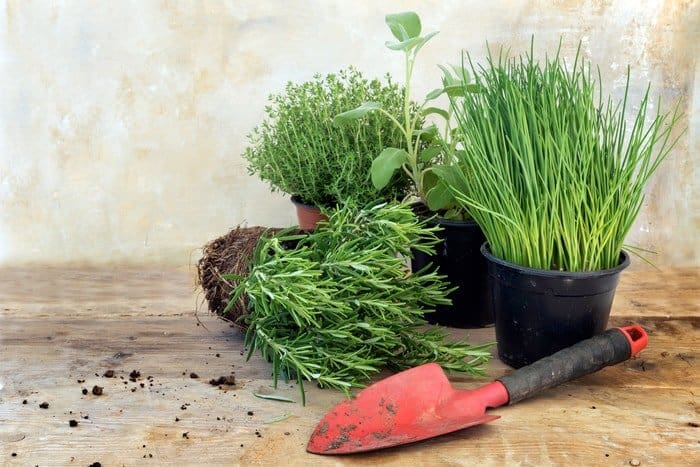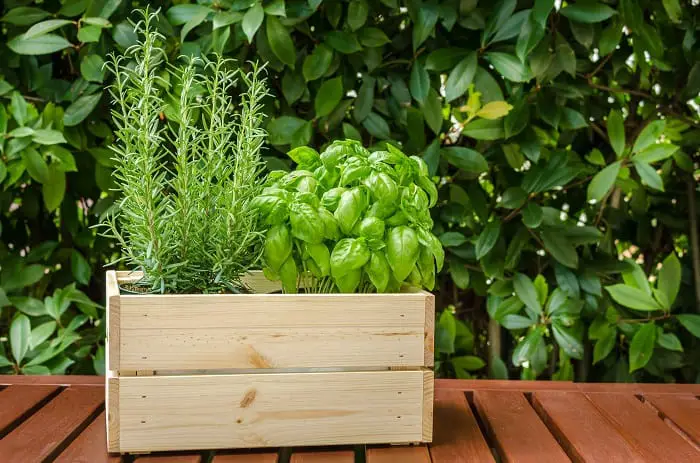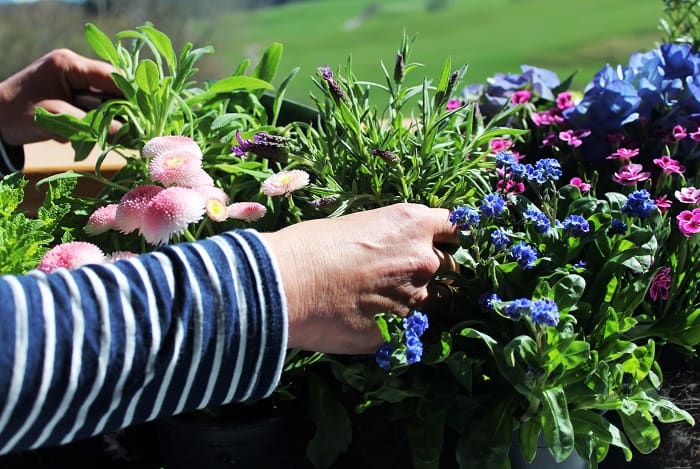Last Updated on December 30, 2021 by
If you’re a gardener, then there’s a high chance you’ve probably come across or heard about companion planting. Finding combinations of plants and herbs that can grow well with each other in groups or in pairs is something most gardeners tend to do a lot. Anyway, if you’ve been wondering what herbs can be planted together with other plants, you’re in the right place. This article will highlight a few of the most common compatible herb plants.
Companion planting also has a science behind it. Some herb plants can prove very beneficial to your garden. For example, herbs that have strong fragrances are well-known to have a plethora of gardening benefits. From warding off garden misfits by enticing beneficial insects to feed on them to just directly driving away from the pests.
Let’s take a look at some of the most compatible herb plants available.
What Herbs Can Be Planted Together
1. Rosemary
Okay, this herb is among the few that don’t get along with its other herb counterparts. In fact, the only good garden buddy, as far as herbs are concerned, to rosemary is sage. However, it happens to be a great complement to many other vegetables.
The garden plant that rosemary complements the best is, no doubt, broccoli. Rosemary protects the broccoli heads from the insects that feed on them while broccoli plants allow the rosemary to thrive by enriching the soil around them. Rosemary also enjoys growing besides hot peppers, cabbage, and beans.
2. Chives
If you’re looking for an herb that grows well with other herbs, then chives should be your go-to. Chives love growing besides almost every other herb. They’re also particularly good at enticing pollinators which, in turn, help increase the yield of several other vegetables and fruits.
They grow well next to celery, lettuce, peas, and vegetables that are prone to be attacked by aphids. Also, both the flavor and length of carrots can be enhanced by chives.
What Herbs Can Be Planted Together: Essentials
3. Basil
Like rosemary, basil doesn’t tend to get along well with other herbs. They prefer the company of vegetables instead. But, it does have some exceptions. Two, to be exact, unlike the one for rosemary. Basil should be partnered with chamomile and oregano.
It can be grown with a few other herbs, but sage and rue should be kept away from it at all costs. As far as veggie-herb combinations are concerned, basil and tomatoes are basically the best of friends. Not only do they make the perfect combo on Margherita pizza, but they also make perfect garden partners.
4. Herbs Can Be Planted Together, Mint
Before adding mint to any garden, always keep in mind that it happens to be a very invasive plant. So, if you intend on planting them in beds rather than containers, prepare for it to spread to areas that it doesn’t belong in. However, you never really need a lot of mint top, to begin with, even if you knock down mint tea or mojitos like no one’s business.
With that said, in the garden, excessive amounts of a good thing is never a bad idea. The strong mint aroma wards off a lot of pests, including flea beetles and aphids. Mint should be planted near radish, cauliflower, kale, and cabbage. Peas, lettuce, beets, broccoli, and squash also grow well beside mint.
5. Sage
Another herb that really loves growing near fruits and vegetables, instead of other herbs, is sage. In fact, the only herb sage is compatible with is rosemary. Your vegetable garden is the perfect place for this herb. You should grow sage around cabbage, carrots, tomatoes, and strawberries.
Also, you might want to consider letting the sage plants flower in the garden. Why? Because not only do they entice pollinators and beneficial insects that’ll help the whole garden but their blossom is quite beautiful as well.
More Herbs That Can Be Planted Together
6. Catnip
When catnip plants bloom they attract bees, which we all know are pollinators. This means that, if it’s in your garden, it’ll help with the pollination of the other plants in the area. Furthermore, catnip’s strong fragrance also helps to repel beetles, cockroaches, aphids, ants and more.
In fact, it even has the power to keep at bay large garden pests, the likes of weevils, rats, and mice. Catnip should be planted in the garden beds’ outer borders, along with hyssop. It pairs well with squash, pumpkins, and beets.
7. Tarragon
If you’re looking for a nurse plant, tarragon is what you should be considering. What’s a nurse plant? It’s a plant that’ll help increase the growth and enhance the flavor of the other vegetation it’s planted next to. Tarragon can literally fit into any garden. Many pests are driven away by the smell of tarragon.
It also works as a good barrier plant for when you want to divide your garden bed up into sections. Tarragon loves bunking beside eggplant, especially because eggplant is a special treat for most garden pests and tarragon’s strong odor helps drive these pests away.
8. Dill
Dill attracts almost all the beneficial insects you’d want in your garden. Some of these include hoverflies, wasps, honey bees, butterflies, ladybugs as well as the ever so majestic praying mantis. This herb also helps keep spider mites, cabbage loopers, and aphids at bay.
Vegetables that are dill-compatible include onions, asparagus, corn, cucumbers, lettuce, broccoli, cabbage, Brussels sprouts, and kohlrabi. However, they don’t grow well alongside eggplant, carrots, potatoes, and peppers in the vegetable garden. When it comes to herbs, on the other hand, keep it far away from lavender.
Conclusion
Some herbs, as you can see, are exceptional companion plants. They do this just as well as veggies do, some maybe even better. One of the reasons why they do this is because of the strong essential oil odor they produce, which often do well at keeping unwanted pests at bay. Herbs can also help increase both the flavor and output of the compatible plants they’ve been planted next to. So, hopefully, now that you know what to put next to what you can go and add a few herbs in your garden.
FAQs
Which herbs Cannot be planted together?
Some herbs are not meant to be planted together. These are some of the most common herbs that cannot be planted together in different regions of the world.
Basil and thyme: Basil and thyme have similar but contrasting tastes. Basil is a tender herb that has a slight, sweet flavor while thyme has a more earthy, peppery taste. When you plant these two herbs next to each other, they can cross-pollinate and create an unwanted hybrid of both flavors.
Some other herbs that cannot be planted together include oregano and cinnamon, parsley and sage, rosemary and lavender, mint and sage, and mint with any citrus trees or fruit trees.
Can you plant parsley and basil together?
They are both annual herbs that do not survive freezing temperatures, so planting them side by side will not harm them.
Parsley and basil are two popular herb plants. However, there is one thing that might stop you from planting them together - they need different growing conditions. Parsley needs lots of sun and a rich compost while basil prefers less sun and a lighter compost such as regular potting soil or garden soil.
Does rosemary and cilantro go together?
Rosemary and cilantro are two herbs that usually go together. But, does this pairing work?
Some people say that they absolutely do not work together. They have a strong taste and smell that clashes with the smell of cilantro. Others say they co-exist nicely but you need to be careful when you cook with these two because they can alter the flavor of foods as well as make them more difficult to digest.
What herbs go with mint?
Basil is a herb that goes well with mint because it has a strong smell and a sour taste. Mint, when paired with parsley, washes the taste away and leaves a refreshing aftertaste. However, there are other herbs that also go well with mint such as oregano and thyme which give it an earthy taste.
What herbs and vegetables can be planted together?
There are a few factors to consider before planting herbs and vegetables together: soil, sunlight and space. The most important factor is the soil.
Some herbs can be planted with tomatoes without any problem, but others cannot. One plant that can be planted with tomatoes is basil, so basil is an excellent herb for a tomato-basil combo garden.
A few vegetables that can be planted together are peppers, eggplant and zucchini.
It is important to find out which vegetables can be planted with which herbs. The following is a list of the herbs and vegetables that can be planted together:
-Beets, sage, thyme, cilantro
-Carrots, parsley, basil
-Celery, oregano
-Kale, marjoram.
Can all herbs be planted together?
When planting herbs, it is important to understand the compatibility of the herbs. Some herbs can go well with each other and some can't.
In order for the plants to grow well together, it is recommended that three types of soil should be used in the pot: good quality topsoil, sterilized topsoil and composted manure.
Plants that typically go well together are mints, lavender and basil
In order to keep these plants healthy while they are growing in a pot together, plant them away from direct sunlight
Tony Manhart is a passionate gardener who has been tending to gardens for over 20 years. He takes pride in creating beautiful outdoor spaces with plants, trees, and shrubs that can thrive in any environment. He loves to share his knowledge with others and has taught classes on gardening basics and advanced techniques. He is committed to sustainability, using natural and organic methods to create and maintain gardens. He also works with local organizations to create green spaces for communities. When he’s not gardening, Tony enjoys hiking, reading, and spending time with his family.





